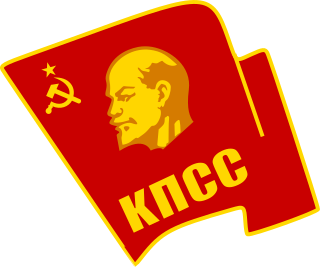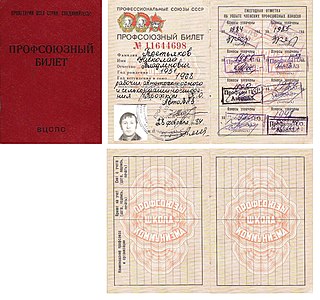Related Research Articles

The Communist Party of the Soviet Union (CPSU), at some points known as the Russian Communist Party (Bolsheviks) and All-Union Communist Party (Bolsheviks) and sometimes referred to as the Soviet Communist Party (SCP), was the founding and ruling political party of the Soviet Union. The CPSU was the sole governing party of the Soviet Union until 1990 when the Congress of People's Deputies modified Article 6 of the 1977 Soviet Constitution, which had previously granted the CPSU a monopoly over the political system.

Lev Davidovich Bronstein, better known as Leon Trotsky, was a Russian revolutionary, Soviet politician, journalist, and political theorist. He was a central figure in the October Revolution, Russian Civil War, and the establishment of the Soviet Union. Ideologically a Marxist and a Leninist, Trotsky's thought and writings inspired a school of Marxism known as Trotskyism.

Leninism is a political ideology developed by Russian Marxist revolutionary Vladimir Lenin that proposes the establishment of the dictatorship of the proletariat led by a revolutionary vanguard party as the political prelude to the establishment of communism. The function of the Leninist vanguard party is to provide the working classes with the political consciousness and revolutionary leadership necessary to depose capitalism.

The Workers' Opposition was a faction of the Russian Communist Party that emerged in 1920 as a response to the perceived over-bureaucratisation that was occurring in Soviet Russia. They advocated the transfer of national economic management to trade unions. The group was led by Alexander Shlyapnikov, Sergei Medvedev, Alexandra Kollontai and Yuri Lutovinov. It officially existed until March 1921 when it was forced to dissolve by the 10th Congress of the Russian Communist Party (Bolsheviks), and semi-clandestinely until the subsequent 11th Congress in 1922, where its main exponents teetered dangerously on the verge of being purged for fractionist activity. In some aspects, it was close with the German council communist movement, although there is no information about direct contacts between these groups.
The history of the Communist Party of the Soviet Union was generally perceived as covering that of the Bolshevik faction of the Russian Social Democratic Labour Party from which it evolved. The date 1912 is often identified as the time of the formation of the Communist Party of the Soviet Union as a distinct party, and its history since then can roughly be divided into the following periods:
A People's Commissariat was a structure in the Soviet state from 1917–1946 which functioned as the central executive body in charge of managing a particular field of state activity or a separate sector of the national economy; analogue of the ministry. As a rule, a People's Commissariat was headed by a People's Commissar, which is part of the government – the Council of People's Commissars of the appropriate level.

The All-Russian Central Executive Committee (ARCEC) was the highest legislative, administrative and revising body of the Russian Soviet Federative Socialist Republic from 1917 until 1937. Although the All-Russian Congress of Soviets had supreme authority in the RSFSR, in periods between Congress sessions its powers passed to the VCIK.

The Petersburg Soviet of Workers' Delegates was a workers' council, or soviet, in Saint Petersburg in 1905.
The Council of Labor and Defense, first established as the Council of Workers' and Peasants' Defense in November 1918, was an agency responsible for the central management of the economy and production of military materiel in the Russian Socialist Federative Soviet Republic and later in the Soviet Union. During the Russian Civil War of 1917-1922 the council served as an emergency "national economic cabinet", issuing emergency decrees in an effort to sustain industrial production for the Red Army amidst economic collapse. In 1920–23 it existed on the rights of the commission of the Russian Sovnarkom and after 1923 of the Soviet Council of People's Commissariats. The Central Executive Committee of the Soviet Union abolished the council on 28 April 1937. Its functions were split between the Economic Council of the Council of People's Commissars of the Soviet Union and the Defense Committee of the Council of People's Commissars of the Soviet Union.
The People's Commissariat of the Workers' and Peasants' Inspection, also known as Rabkrin, was a governmental establishment in the Soviet Union of ministerial level that was responsible for scrutinizing the state, local and enterprise administrations.

The Ministry of Finance of the Union of Soviet Socialist Republics (USSR) (Russian: Министерство финансов СССР), formed on 15 March 1946, was one of the most important government offices in the Soviet Union. Until 1946 it was known as the People's Commissariat for Finance (Russian: Народный комиссариат финансов – Narodnyi komissariat finansov, or "Narkomfin"). Narkomfin, at the all-Union level, was established on 6 July 1923 after the signing of the Treaty on the Creation of the USSR, and was based upon the People's Commissariat for Finance of the Russian Soviet Federative Socialist Republic (RSFSR) formed in 1917. The Ministry was led by the Minister of Finance, prior to 1946 a Commissar, who was nominated by the Chairman of the Council of Ministers and then confirmed by the Presidium of the Supreme Soviet. The minister was a member of the Council of Ministers.
Heinrich Brandler was a German communist, trade unionist, politician, revolutionary activist, and political writer. Brandler is best remembered as the head of the Communist Party of Germany (KPD) during the party's ill-fated "March Action" of 1921 and aborted uprising of 1923, for which he was held responsible by the Communist International. Expelled from the Communist Party in December 1928, Brandler went on to become co-founder of the Communist Party of Germany Opposition, the first national section of the so-called International Right Opposition.

Joseph Stalin started his career as a radical student, becoming an influential member and eventually the leader of the Bolshevik faction of the Russian Social Democratic Labour Party. He served as the General Secretary of the Central Committee of the Communist Party of the Soviet Union from 1922 until his death in 1953.

The Government of the Soviet Union, formally the All-Union Government of the Union of Soviet Socialist Republics, commonly abbreviated to Soviet Government, was the executive and administrative organ of state in the former Soviet Union. It had four different names throughout its existence; Council of People's Commissars (1923–1946), Council of Ministers (1946–1991), Cabinet of Ministers and Committee on the Operational Management of the National Economy. It also was known as Workers-Peasants Government of the Soviet Union during the Stalin era.

The All-Russian Congress of Soviets evolved from 1917 to become the supreme governing body of the Russian Soviet Federative Socialist Republic from 1918 until 1936, effectively. The 1918 Constitution of the Russian SFSR mandated that Congress shall convene at least twice a year, with the duties of defining the principles of the Soviet Constitution and ratifying peace treaties. The October Revolution ousted the provisional government of 1917, making the Congress of Soviets the sole, and supreme governing body. This Congress was not the same as the Congress of Soviets of the Soviet Union which governed the whole Soviet Union after its creation in 1922.

Trade unions in the Soviet Union, headed by the All-Union Central Council of Trade Unions, had a complex relationship with industrial management, the Communist Party of the Soviet Union, and the Soviet government, given that the Soviet Union was ideologically supposed to be a state in which the members of the working class both ruled the country and managed themselves.

The New Economic Policy (NEP) was an economic policy of the Soviet Union proposed by Vladimir Lenin in 1921 as a temporary expedient. Lenin characterized the NEP in 1922 as an economic system that would include "a free market and capitalism, both subject to state control", while socialized state enterprises would operate on "a profit basis".

The Central Committee of the Communist Party of the Soviet Union was the executive leadership of the Communist Party of the Soviet Union, acting between sessions of Congress. According to party statutes, the committee directed all party and governmental activities. Its members were elected by the Party Congress.

Democratic centralism is the organisational principle of socialist states and of most communist parties. In practice, democratic centralism means that political decisions reached by voting processes are binding upon all members of the political party. It is mainly associated with Leninism, wherein the party's political vanguard of revolutionaries practice democratic centralism to select leaders and officers, determine policy, and execute it.
References
- ↑ Deutscher, Isaac. "Soviet Trade Unions: Their Place in Soviet Labour Policy by Isaac Deutscher 1950". www.marxists.org. Retrieved 28 August 2017.
- 1 2 3 Hewes, Amy (1923). "Trade Union Development in Soviet Russia". The American Economic Review. 13 (4): 618–637. ISSN 0002-8282 . Retrieved 20 August 2021.